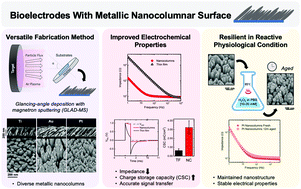Effects of nanostructuration on the electrochemical performance of metallic bioelectrodes†
Abstract
The use of metallic nanostructures in the fabrication of bioelectrodes (e.g., neural implants) is gaining attention nowadays. Nanostructures provide increased surface area that might benefit the performance of bioelectrodes. However, there is a need for comprehensive studies that assess electrochemical performance of nanostructured surfaces in physiological and relevant working conditions. Here, we introduce a versatile scalable fabrication method based on magnetron sputtering to develop analogous metallic nanocolumnar structures (NCs) and thin films (TFs) from Ti, Au, and Pt. We show that NCs contribute significantly to reduce the impedance of metallic surfaces. Charge storage capacity of Pt NCs is remarkably higher than that of Pt TFs and that of the other metals in both morphologies. Circuit simulations of the electrode/electrolyte interface show that the signal delivered in voltage-controlled systems is less filtered when nanocolumns are used. In a current-controlled system, simulation shows that NCs provide safer stimulation conditions compared to TFs. We have assessed the durability of NCs and TFs for potential use in vivo by reactive accelerated aging test, mimicking one-year in vivo implantation. Although each metal/morphology reveals a unique response to aging, NCs show overall more stable electrochemical properties compared to TFs in spite of their porous structure.



 Please wait while we load your content...
Please wait while we load your content...